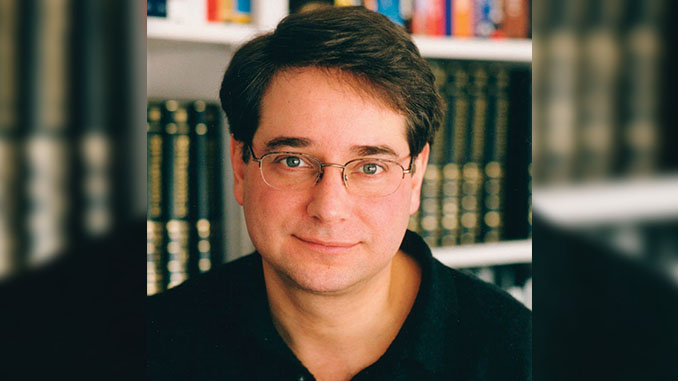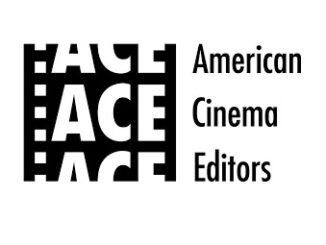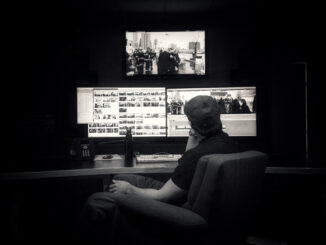
by Damian Begley
Andrew Mondshein is an Oscar nominee for his work on the critically acclaimed and commercially successful,The Sixth Sense. He was also nominated for an ACE Award and has won the Golden Satellite Award. He grew up along the East Coast, eventually settling in Florida. Upon graduating from the University of Florida, he drove up to New York City and right into the motion picture industry. After assisting current 700 Board member Peter Frank on a couple of Sidney Lumet movies, Andy, at age 26, was given a shot to edit his first feature, Garbo Talks. He soon became the first editor to cut a feature film on a non-linear electronic system when he edited Lumet’s Power on the Montage in 1985. His credits include Return to Paradise, To Wong Foo, Thanks For Everything, Julie Newmar, What’s Eating Gilbert Grape?, Cookie, Making Mr. Right, Running on Empty and Desperately Seeking Susan. He recently directed Evidence of Blood for Showtime. Andy lives with his wife, producer Leslie Holleran, and their two sons, Spencer and Taylor, in Larchmont, New York. He will soon start work on Chocolat for director Lasse Hallstrom.
CineMontage: How did you get involved with The Sixth Sense?
Andy Mondshein: I cut Night’s (writer-director M. Night Shyamalan) previous film, Wide Awake. During the extended post on that film he was working on the script for Sixth Sense.
CM: What did you think of the script in general and especially the ending?
AM: Whenever you read a script written by a friend there’s a mixture of excitement and trepidation. Fortunately, in this instance I loved it. I was blown away by it. It is one of the great truths of making movies: if you don’t have a strong script you’re swinging at windmills. It was a good story, well told.
CM: …with an amazing ending!
AM: One of the most stunning endings I’ve ever seen or read. This ending was so integral to the story. It was a seismic event, like the ground shifted underneath you. We had to be meticulous about creating the rules of this world and maintaining them, but all the while keeping our secret. If people figured it out, we were essentially screwed. We were pretty certain people would scrutinize the movie again on videotape. We didn’t expect people to go back and see it in the theater. We tried to keep a sense of reality.
“Digital technology is changing the progression of the hierarchy. I trained standing next to an editor and a trim bin. The Avid has allowed for more solitary editing. And unfortunately the assistants’ training suffers.” -Andy Mondshein
CM: Did you cut The Sixth Sense electronically?
AM: Absolutely. In 1985 I became the first editor to cut a feature film on a non-linear system. From that point on I’ve been involved in electronic editing. Actually, I went back and forth from a moviola (Running on Empty, Desperately Seeking Susan) to Montage, then Avid.
CM: Tell us about the Montage and the beginning of non-linear electronic editing.
AM: Well, in the spring of 1985 I heard that two new electronic editing systems were almost ready to hit the market: the Montage and the Editdroid (George Lucas’ system). I talked with Sidney Lumet, who was in pre-production on Power, about the idea of using these systems. With his extensive television background (he had directed over 230 live productions by the time he was 33) he was open and excited about the possibilities. The film software for the Montage was ready first, so I trained on that system and ran a test edit session with Sidney. He said, “What the hell, let’s give it a try.” We actually cut the film out in East Hampton where Sidney has a summer house, and Montage had an engineer there for the duration of the director’s cut. They had the entire software team up in Massachusetts working on new things that we needed the system to do. No question we were on the vanguard but we felt more like guinea pigs.
CM: How different was it going from film to a computer?
AM: I must say it was both exhilarating and frustrating. At first, we were trying to overcome some of the most basic technical hurdles. This was even before we began to consider the broader questions of whether this new tool was going to ultimately change the process in some way that indeed might result in a broader change in films. It seems fairly clear that the history of film is an evolving art form rooted in technological developments. Of course, with any new technology there’s both a nostalgia for the old way and some real fundamental process changes that arguably are not always for the better. In the instance of non-linear editing, I’m a firm believer that the positives far outweigh the negatives.
CM: At this point do you see yourself going back to film?
AM: I could, but the integration of the Avid into the entire post production process has gotten deeper and deeper. The next step–which has already happened–is the elimination of mag track from the process. That will help to bring down the costs that the Avid adds to the budget. To answer your question, I doubt I’ll be going back.

CM: What about other systems? Lightworks? Final Cut Pro?
AM: I’m open, but I’m more comfortable on the Macintosh system. I think the Avid has so much more going for it. It’s more flexible, it’s editor-friendly. And it allows you to focus more on the creative part of the editing and less on the manual part.
CM: Has the opportunity come up where you’ve edited a piece that originated on digital video?
AM: A few years ago I cut a short that was one of the first to be shot on High-Definition video. There were no real fundamental differences in the editing process. Digital video, I believe, is a wave of opportunity that will sweep over television, documentaries, the internet and even independent features over the next five to ten years, and will coexist but not supplant the rest of the feature world–for a long time, anyway.
CM: Since you started working on the Avid are you doing more than just picture editing?
AM: Sure. There’s no question that you do more sound effects work because you have all the additional tracks available. You can do dissolves, you can eq dialog tracks, do temp scoring, etc. But it has not diminished the amount of work that my sound editor or my music editor ends up doing. It’s more of a blueprint of some ideas.
CM: What is the future of the assistant editor?
AM: Well, digital technology is changing the progression of the hierarchy. I trained standing next to an editor and a trim bin. The Avid has allowed for more solitary editing. And unfortunately the assistants’ training suffers. To some degree it has diminished the apprenticeship. On the other hand, the Avid is the greatest teaching tool for editing that has ever come along.
“In 1985 I became the first editor to cut a feature film on a non-linear system. From that point on I’ve been involved in electronic editing.” – Andy Mondshein
CM: Explain that.
AM: If you have an Avid in a classroom facility, the ability for everyone in the class to have all the material, and then show what the original editor did with the same material, and what the alternatives were, etc. makes it an enormously valuable tool. So, the ambitious assistant has at his or her disposal, in off hours, a machine where they can work on the material and try things out. But overall I think there is a balance, both positive and negative, to this system.
CM: How about two Avids in a room?
AM: That’s already happening. On lots of films. Two Avids will become the norm, which also will free up the assistant to do some assembling.
CM: Ever think of wearing another hat–as a writer, director, or even a producer?
AM: I first got into editing with an eye to directing. After directing Second Unit on seven features, including The Sixth Sense, I did get the opportunity to direct a film for MGM/Showtime called Evidence of Blood, starring David Strathairn and Mary McDonnell. Bad title, I know, but a much better movie I’ve been told. I must say, it was both a brutally difficult and tremendously rewarding experience. If it’s possible, I have an even greater respect for how consuming directing can be. I hope to edit and direct in the future.
CM: How did you get interested in editing?
AM: I always had an innate interest in film. The University of Florida, where I went to college, had a very strong broadcast department. Somewhere along the way I was challenged to cut a piece I shot. It turned out well. I found I had an interest in and an aptitude for editing. I was influenced by films of the ’60s and ’70s: Lumet, Kubrik–especially 2001. That probably was the moment that I decided I had to be involved in movies. But I was extremely lucky that when I started working in the industry I started in sound. I think my sound editing training has paid enormous dividends in my ability to cut picture. It has widened the tools I have available. I chose editing as a way to learn the filmmaking process and fell in love with it!





